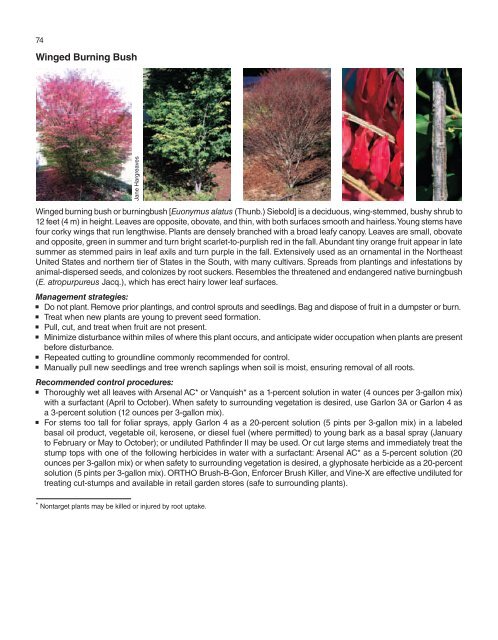74W<strong>in</strong>ged Burn<strong>in</strong>g BushJane HargreavesW<strong>in</strong>ged burn<strong>in</strong>g bush or burn<strong>in</strong>gbush [Euonymus alatus (Thunb.) Siebold] is a deciduous, w<strong>in</strong>g-stemmed, bushy shrub to12 feet (4 m) <strong>in</strong> height. Leaves are opposite, obovate, and th<strong>in</strong>, with both surfaces smooth and hairless. Young stems havefour corky w<strong>in</strong>gs that run lengthwise. <strong>Plants</strong> are densely branched with a broad leafy canopy. Leaves are small, obovateand opposite, green <strong>in</strong> summer and turn bright scarlet-to-purplish red <strong>in</strong> the fall. Abundant t<strong>in</strong>y orange fruit appear <strong>in</strong> latesummer as stemmed pairs <strong>in</strong> leaf axils and turn purple <strong>in</strong> the fall. Extensively used as an ornamental <strong>in</strong> the NortheastUnited States and northern tier of States <strong>in</strong> the South, with many cultivars. Spreads from plant<strong>in</strong>gs and <strong>in</strong>festations byanimal-dispersed seeds, and colonizes by root suckers. Resembles the threatened and endangered native burn<strong>in</strong>gbush(E. atropurpureus Jacq.), which has erect hairy lower leaf surfaces.<strong>Management</strong> strategies:Do not plant. Remove prior plant<strong>in</strong>gs, and control sprouts and seedl<strong>in</strong>gs. Bag and dispose of fruit <strong>in</strong> a dumpster or burn.Treat when new plants are young to prevent seed <strong>for</strong>mation.Pull, cut, and treat when fruit are not present.M<strong>in</strong>imize disturbance with<strong>in</strong> miles of where this plant occurs, and anticipate wider occupation when plants are presentbe<strong>for</strong>e disturbance.Repeated cutt<strong>in</strong>g to groundl<strong>in</strong>e commonly recommended <strong>for</strong> control.Manually pull new seedl<strong>in</strong>gs and tree wrench sapl<strong>in</strong>gs when soil is moist, ensur<strong>in</strong>g removal of all roots.Recommended control procedures:Thoroughly wet all leaves with Arsenal AC* or Vanquish* as a 1-percent solution <strong>in</strong> water (4 ounces per 3-gallon mix)with a surfactant (April to October). When safety to surround<strong>in</strong>g vegetation is desired, use Garlon 3A or Garlon 4 asa 3-percent solution (12 ounces per 3-gallon mix).For stems too tall <strong>for</strong> foliar sprays, apply Garlon 4 as a 20-percent solution (5 p<strong>in</strong>ts per 3-gallon mix) <strong>in</strong> a labeledbasal oil product, vegetable oil, kerosene, or diesel fuel (where permitted) to young bark as a basal spray (Januaryto February or May to October); or undiluted Pathf<strong>in</strong>der II may be used. Or cut large stems and immediately treat thestump tops with one of the follow<strong>in</strong>g herbicides <strong>in</strong> water with a surfactant: Arsenal AC* as a 5-percent solution (20ounces per 3-gallon mix) or when safety to surround<strong>in</strong>g vegetation is desired, a glyphosate herbicide as a 20-percentsolution (5 p<strong>in</strong>ts per 3-gallon mix). ORTHO Brush-B-Gon, En<strong>for</strong>cer Brush Killer, and V<strong>in</strong>e-X are effective undiluted <strong>for</strong>treat<strong>in</strong>g cut-stumps and available <strong>in</strong> retail garden stores (safe to surround<strong>in</strong>g plants).* Nontarget plants may be killed or <strong>in</strong>jured by root uptake.
<strong>Invasive</strong> V<strong>in</strong>es<strong>Invasive</strong> v<strong>in</strong>es are some of the most troublesome <strong>in</strong>vaders because they often <strong>for</strong>m the densest <strong>in</strong>festations, mak<strong>in</strong>gherbicide applications and other treatments difficult. Many of these v<strong>in</strong>es overtop even mature <strong>for</strong>ests and often <strong>for</strong>mmixed-species <strong>in</strong>festations with <strong>in</strong>vasive trees and shrubs. Specific herbicides can be effective on certa<strong>in</strong> v<strong>in</strong>es while notcontroll<strong>in</strong>g but actually releas<strong>in</strong>g any underly<strong>in</strong>g nonnative trees and shrubs. In these situations, select the best herbicideor herbicide mixture <strong>for</strong> controll<strong>in</strong>g all the <strong>in</strong>vasive species <strong>in</strong> a mixed-species <strong>in</strong>festation. V<strong>in</strong>e control is always difficultbecause foliar-active herbicides must move through lengthy v<strong>in</strong>es to kill large woody roots and root crowns. Thus, herbicidesthat have both soil and foliar activity are often the most effective. Only the lower foliage with<strong>in</strong> sprayer reach needsto be treated with a herbicide hav<strong>in</strong>g both foliar and soil activity. With all herbicides, spray foliage of climb<strong>in</strong>g stems ashigh as possible and if not controlled, then cut v<strong>in</strong>es. Treat cut stems or allow sprout<strong>in</strong>g be<strong>for</strong>e foliar retreatment. Whencutt<strong>in</strong>g treatments are used, cut as low as possible and also remove the upper portion high enough to prevent regrowthreach<strong>in</strong>g the upper v<strong>in</strong>e to act like a trellis.Amur Pepperv<strong>in</strong>e, Porcela<strong>in</strong> Berry75Amur pepperv<strong>in</strong>e or porcela<strong>in</strong> berry [Ampelopsis brevipedunculata (Maxim.) Trautv.] is a deciduous, woody v<strong>in</strong>e of thegrape family to 20 feet (5 m) long with hairy stems. It runs and climbs over shrub and tree crowns as well as rock facesby cl<strong>in</strong>g<strong>in</strong>g <strong>for</strong>ked tendrils, <strong>for</strong>m<strong>in</strong>g thicket and arbor <strong>in</strong>festations. Heart-shaped leaves can have an entire toothed marg<strong>in</strong>or be symmetrically lobed. Flat clusters of <strong>in</strong>conspicuous yellowish flowers <strong>in</strong> spr<strong>in</strong>g yield multicolored spherical fruit ofwhite, green, or blue <strong>in</strong> the fall and w<strong>in</strong>ter. Seed spread by animals, water, and gravity. Colonizes by prolific v<strong>in</strong>e growththat roots at nodes when touch<strong>in</strong>g the soil. Effective control requires dedicated followup because porcela<strong>in</strong> berry v<strong>in</strong>escan grow up to 15 feet (4.5 m) <strong>in</strong> a grow<strong>in</strong>g season, especially when ra<strong>in</strong>fall is abundant. Seed may be viable <strong>in</strong> the soil<strong>for</strong> several years. Still planted as an ornamental. Resembles the native heartleaf pepperv<strong>in</strong>e (A. cordata Michx.) withunlobed leaves and hairless stems, which can also <strong>for</strong>m <strong>in</strong>festations on fences and shrubs.<strong>Management</strong> strategies:Do not plant. Remove prior plant<strong>in</strong>gs, and control sprouts and seedl<strong>in</strong>gs. Bag and dispose of fruit <strong>in</strong> a dumpster or burn.M<strong>in</strong>imize disturbance with<strong>in</strong> miles of where this plant occurs, and anticipate wider occupation when plants are presentbe<strong>for</strong>e disturbance.Treat when new plants are young to prevent seed <strong>for</strong>mation.Pull, cut, and treat when fruit are not present.Manually pull new seedl<strong>in</strong>gs when soil is moist, ensur<strong>in</strong>g removal of all roots.Recommended control procedures:Thoroughly wet all leaves with one of the follow<strong>in</strong>g herbicides <strong>in</strong> water with a surfactant: a glyphosate herbicide orGarlon 3A as a 2- to 3-percent solution (8 to 12 ounces per 3-gallon mix). When nontarget damage is not a concern,apply Arsenal AC* as a 0.25-percent solution (1 ounce per 3-gallon mix) or Chopper Gen 2* as a 0.5-percent solution(2 ounces per 3-gallon mix) <strong>in</strong> water.To control climb<strong>in</strong>g v<strong>in</strong>es, cut large stems close to ground level and immediately treat the stump tops with Garlon3A or a glyphosate herbicide with a 25-percent solution (3 quarts per 3-gallon mix). ORTHO Brush-B-Gon, En<strong>for</strong>cerBrush Killer, and V<strong>in</strong>e-X are effective undiluted <strong>for</strong> treat<strong>in</strong>g cut-stumps and available <strong>in</strong> retail garden stores (safe tosurround<strong>in</strong>g plants). For large v<strong>in</strong>es, make stem <strong>in</strong>jections us<strong>in</strong>g Arsenal AC*, Garlon 3A, or a glyphosate herbicidewith dilutions and cut-spac<strong>in</strong>gs specified on the herbicide label (anytime except March and April). The EZ-Ject tree<strong>in</strong>jector assists <strong>in</strong> reach<strong>in</strong>g through entanglements to treat.* Nontarget plants may be killed or <strong>in</strong>jured by root uptake.
















